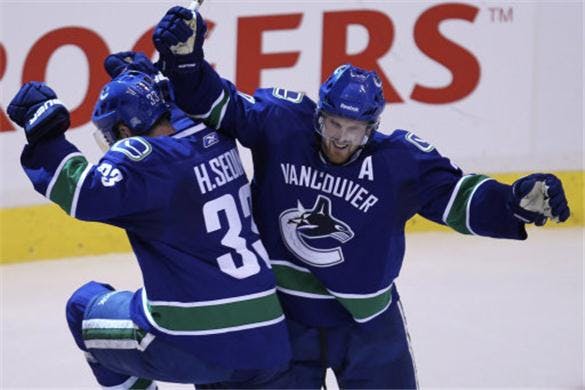Reasons To Get Excited Part II
By Jeff Angus
12 years ago
Last week, I spoke on five reasons why the Canucks will once again be an elite NHL club – a healthy Alex Burrows, a legitimate fourth line center, internal competition, Cody Hodgson’s great summer, and the development of Chris Tanev. This week I’ll speak on five more reasons why the team will be great once again – leadership, divisional dominance, the ying and yang of Kesler and Henrik Sedin, the team having a bone to pick with the rest of the hockey world, and some common sense thinking.
The leadership group of this team (led by the Sedin twins) doesn’t seem satisfied with previous successes. The Sedin twins established themselves as legitimate first line players before signing five-year extensions back in 2008. Many players would take their new paycheques and deliver the status quo (or worse, like Alexei Yashin). However, Daniel and Henrik took their combined $60 million back to Sweden and trained harder than ever. The outcome since that time has been two Art Ross Trophies, a Hart Trophy, and a lot of embarrassed defensemen on opposing teams. Internally, the even-keeled temperament and long-term perspective from the Sedin twins has been infectious. Bieksa and Kesler have bought in, and Luongo has been able to focus less on the media (a great thing) and more on stopping pucks.
Canuck fans need not worry about the players being satisfied with last season.
The Northwest Division was once arguably the strongest division in the league. No more, as the Canucks walked all over their divisional rivals last season. While the four other teams have made some significant changes this summer (for better or worse, both sides of the coin could be argued for each), the Canucks should once again cruise to a division title. Calgary didn’t do a whole lot, and they traded away a top-four defenseman in Robyn Regehr. They are once again relying a lot on Jarome Iginla and Miikka Kiprusoff. Minnesota added some offense, but at the expense of their best defenseman. Edmonton drafted another future superstar, but they did nothing to improve their abysmal defense or questionable goaltending situation. Colorado made a splash landing a talented – but unproven – young goaltender, and they are relying on a slew of injury-prone forwards to supply a lot of the offense. Vancouver lost their power play quarterback, but their defensive group is balanced. Up front, they are much improved from where they stood one year ago today.
24 games against the division will help Vancouver contend with Detroit, Chicago, San Jose, and Los Angeles for Western Conference supremacy.
I spoke with an NHL pro scout last year (not one working for Vancouver) and asked him what aspects about the Canucks scared other teams the most. Aside from the usual answers (Sedin twins, depth, power play, Luongo’s greased up hair), he told me something that made a lot of sense – Henrik and Kesler are polar opposite players, and teams found it tough to game plan for both of them. The Sedins have gotten better at creating off of the rush over the past few years, but for the most part they still like to set up in the offensive zone. Henrik is allergic to shooting the puck, and he doesn’t initiate contact (although he doesn’t shy away from it, either). Kesler has developed a wicked shot and he loves to use it, he creates almost all of his offense off of the rush, and he thrives while playing a physically punishing game. It must be hard as an opposing defenseman to have to adjust your style so much in one game. Gap control against Sedin and gap control against Kesler are far from the same thing.
Looking around the league, are there any other center combinations that are so effective because they are such opposite players? Anze Kopitar/Mike Richards in Los Angeles have the potential to be one.
This team, the fans, the management, and the coaching staff have a significantly large chip on their collective shoulder right now. The “us against them” mentality should be employed this season. We saw last spring what happens when the referees put their whistle away in a series featuring a physically punishing team who excels at even strength against an offensive juggernaut with a lethal power play (spoiler alert – not good for the Canucks). The Canucks played whistle to whistle all season and postseason (save for a few lapses in the Chicago series). It helped them the majority of the time, but ended up hurting them when it mattered most. The team now knows what to expect should they make it that far again.
“Us against them” is a cliché rallying cry for a reason – it works.
At the end of the day, this is still a very good hockey team. Last season, the Canucks were the highest scoring team, the stingiest defensive team, the best team on the power play, the best team in the faceoff circle, and one of the best on the penalty kill. Predicting a slight drop off in power play production due to the loss of Ehrhoff wouldn’t be a huge leap of faith, but this team could and should be just as good – or even better – defensively in 2011-12. Better depth up front, a more balanced defensive group, and two fantastic goaltenders playing in a weak division and behind a strong and balanced team.
Recent articles from Jeff Angus





